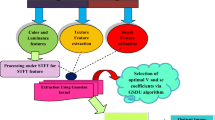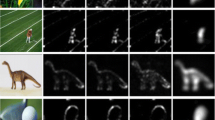Abstract
So far a number of saliency detection designs have been developed for various applications in multimedia scenario. However, certain applications of stereoscopic imaging necessitate enhancing saliency detection designs to extract the salient areas accurately. Saliency detection strategy still faces many challenges like complexity in natural images as well as lesser-scale patterns in salient objects. This paper is set to obtain the saliency detection technique in two stages: feature extraction and depth saliency detection. Gaussian Kernel model is used to extract the features and Gabor filter to get the depth saliency map. This paper optimizes two coefficients namely feature difference among image patches \( U \), from feature evaluation and fine scale \( c \), from which the accurate detection can be achieved. For this, a renowned optimization algorithm named grey wolf optimization (GWO) is used, which is a recently proposed intelligent optimization method inspired by hunting behavior of grey wolves. The saliency detection model detection model is implemented in MATLAB 2015a. To the next of implementation, the performance of the proposed model, GWO-3-dimensional saliency mapping is compared over other the conventional algorithms in terms of receiver operator curve, Pearson correlation coefficient, Kullback–Leibler divergence and area under the curve. The overall performance analysis in terms of above measures and a valuable statistical analysis are carried out for validating the effectiveness of proposed model. The entire analysis proves that the proposed saliency detection performs better than the conventional models.






Similar content being viewed by others
References
Abualigah LM, Khader AT, Hanandeh ES (2018a) A combination of objective functions and hybrid krill herd algorithm for text document clustering analysis. Eng Appl Artif Intell 73:111–125
Abualigah LM, Khader AT, Hanandeh ES (2018b) Hybrid clustering analysis using improved krill herd algorithm. Appl Intell 48(11):4047–4071
Al-Sai ZA, Abualigah LM (2017) Big data and E-government: a review. In: 8th International conference on information technology (ICIT), pp 580–587
Amin F, Fahmi A, Abdullah S, Ali A, Ahmed R, Ghani F (2017) Triangular cubic linguistic hesitant fuzzy aggregation operators and their application in group decision making. J Intell Fuzzy Syst 34:2401–2416
An H, Wang D, Pan Z, Chen M, Wang X (2018) Text segmentation of health examination item based on character statistics and information measurement. CAAI Trans Intell Technol 3(1):28–32
Bramhe SS, Dalal A, Tajne D, Marotkar D (2015) glass shaped antenna with defected ground structure for cognitive radio application. Comput Commun Control Autom 13:330–333
Cao Y, Kang K, Zhang S, Zhang J, Wang Z (2016) Automatic tag saliency ranking for stereo images. Neuro Comput 172:9–18
Chen W, Sun T, Li M, Jiang H, Zhou C (2014) A new image co-segmentation method using saliency detection for surveillance image of coal miners. Comput Electr Eng 40(8):227–235
Chen Y, Pan Y, Song M, Wang M (2015) Improved seam carving combining with 3D saliency for image retargeting. Neuro Comput 151:645–653
Cong R, Lei J, Zhang C, Huang Q, Cao X, Hou C (2016) Saliency detection for stereoscopic images based on depth confidence analysis and multiple cues fusion. IEEE J Magaz 23(6):819–823
Dinh CV, Leitner R, Paclik P, Loog M, Duin RPW (2011) SEDMI: saliency based edge detection in multispectral images. Image Vis Comput 29(8):546–556
Divyashree K, Likhithesh MD, Arpitha M, Madan Raj KS, Raghu S (2015) Proof collection from car black box using smart phone for accident detection. Emergency 2(3):9
Du H, Liu Z, Song H, Mei L, Xu Z (2016) Improving RGBD saliency detection using progressive region classification and saliency fusion. IEEE J Magaz 4:8987–8994
Fahmi A, Amin F (2018) Precursor selection for sol-gel synthesis of titanium carbide nanopowders by a new hesitant cubic fuzzy multi-attribute group decision-making model. New Math Nat Comput. https://doi.org/10.1142/S1793005719500091
Fahmi A, Abdullah S, Amin F, Siddque N, Ali A (2017) Aggregation operators on triangular cubic fuzzy numbers and its application to multi-criteria decision making problems. J Intell Fuzzy Syst 33:3323–3337
Fahmi A, Abdullah S, Amin F, Ali A (2018a) Weighted average rating (war) method for solving group decision making problem using triangular cubic fuzzy hybrid aggregation (Tcfha). Punjab Univ J Math 50(1):23–34
Fahmi A, Abdullah S, Amin F, Ali A, Khan WA (2018b) Some geometric operators with triangular cubic linguistic hesitant fuzzy number and their application in group decision-making. J Intell Fuzzy Syst 35(2):2485–2499
Fahmi A, Abdullah S, Amin F, Khan MSA (2018c) Trapezoidal cubic fuzzy number einstein hybrid weighted averaging operators and its application to decision making. Soft Comput. https://doi.org/10.1007/s00500-018-3242-6
Fahmi A, Amin F, Abdullah S, Ali A (2018d) Cubic fuzzy Einstein aggregation operators and its application to decision making. Int J Syst Sci. https://doi.org/10.1080/00207721.2018.1503356
Fang Y, Wang J, Narwaria M, Le Callet P, Lin W (2014a) Saliency detection for stereoscopic images. IEEE J Magaz 23(6):2625–2636
Fang Y, Wang J, Narwaria M, Le Callet P, Lin W (2014b) Saliency detection for stereoscopic images. IEEE Trans Image Process 23(6):2625, 2636
Fang Y, Lin W, Fang Z, Lei J, Le Callet P, Yuan F (2014c) Learning visual saliency for stereoscopic images. In: IEEE conference publications, pp 1–6
Fang Y, Wang J, Yuan Y, Lei J, Le Callet P (2016) Saliency-based stereoscopic image retargeting. Inf Sci 372:347–358
Fang Y, Lei J, Li J, Xu L, Le Callet P (2017) Learning visual saliency from human fixations for stereoscopic images. Neuro Comput 266:284
Harel J, Koch C, Perona P (2006) Graph-based visual saliency
Itti L, Koch C, Niebur E (1998) A model of saliency-based visual attention for rapid scene analysis. IEEE Trans Pattern Anal Mach Intell 20(11):1254–1259
Jiang Q, Shao F, Jiang G, Yu M, Yu C (2015) A depth perception and visual comfort guided computational model for stereoscopic 3D visual saliency. Signal Process Image Commun 38:57–69
Jiang G, Xu H, Yu M, Luo T, Zhang Y (2017) Stereoscopic image quality assessment by learning non-negative matrix factorization-based color visual characteristics and considering binocular interactions. J Vis Commun Image Represent 46:269–279
Jung C, Cao L, Liu H, Kim J (2015) Visual comfort enhancement in stereoscopic 3D images using saliency-adaptive nonlinear disparity mapping. Displays 40:17–23
Li S, Zeng C, Liu S, Fu Y (2017a) Merging fixation for saliency detection in a multilayer graph. Neurocomputing 230:173–183
Li C, Zhang Y, Tu W, Jun C, Liang H, Yu H (2017b) Soft measurement of wood defects based on LDA feature fusion and compressed sensor images. J For Res 28(6):1285–1292
Lin H, Lin C, Zhao Y, Wang A (2017) 3D saliency detection based on background detection. J Vis Commun Image Represent 48:238–253
Liu Z, Le Meur O, Borji A, Li H (2015) Special issue on recent advances in saliency models, applications and evaluations. Signal Process Image Commun 38:1–2
Liu Y, Yang J, Meng Q, Lv Z, Gao Z (2016) Stereoscopic image quality assessment method based on binocular combination saliency model. Signal Process 125:237–248
Mirjalili S, Mirjalili SM, Lewis A (2014) Grey wolf optimizer. Adv Eng Softw 69:46–61
Pedersen MEH, Chipperfield AJ (2010) Simplifying particle swarm optimization. Appl Soft Comput 10:618–628
Peng R, Varshney PK (2015) A human visual system-driven image segmentation algorithm. J Vis Commun Image Represent 26:66–79
Qi J, Dong S, Huang F, Lu H (2017) Saliency detection via joint modeling global shape and local consistency. Neurocomputing 222:81–90
Roy RG, Baidya D (2018) Speed control of DC motor using fuzzy-based intelligent model reference adaptive control scheme. Adv Commun 462:729–735
Shankar A, Jaisankar N (2016) Security enabled cluster head selection for wireless sensor network using improved firefly optimization. In: International conference on soft computing and pattern recognition, pp 176–192
Song H, Liu Z, Du H, Sun G, Le Meur O, Ren T (2017) depth-aware salient object detection and segmentation via multiscale discriminative saliency fusion and bootstrap learning. IEEE J Magaz 26(9):4204–4216
Suganya P, Iyapparaja M, Navaneethan MC, Meenatchi S, Kumar PJ (2018) A privacy-preserving secure access control mechanism in cloud. J Adv Res Dyn Control Syst 13:844–850
Wang Z, Xu G, Wang Z, Zhu C (2016) Saliency detection integrating both background and foreground information. Neurocomputing 216:468–477
Wang W, Shen J, Yu Y, Ma K-L (2017) Stereoscopic thumbnail creation via efficient stereo saliency detection. IEEE J Magaz 23(8):2014–2027
Zhang C, Tao Z, Wei X, Cao X (2015a) A flexible framework of adaptive method selection for image saliency detection. Pattern Recognit Lett 63:66–70
Zhang X, Wang Y, Zhang J, Hu L, Wang M (2015b) Light field saliency vs. 2D saliency: a comparative study. Neuro Comput 166:389–396
Zhang Y, Zhang F, Guo L (2016) Saliency detection by selective colour features. Neurocomputing 203:34–40
Zhou Y, Li X, Gao L (2013) A differential evolution algorithm with intersect mutation operator. Appl Soft Comput 13:390–401
Author information
Authors and Affiliations
Corresponding author
Ethics declarations
Conflict of interest
The author declares that they have no conflict of interest.
Research involving human participants and/or animals
All procedures followed were in accordance with the ethical standards of the responsible committee on human experimentation (institutional and national) and with the Helsinki Declaration of 1975, as revised in 2008.
Informed consent
Informed consent was obtained from all patients for being included in the study.
Additional information
Communicated by P. Pandian.
Publisher’s Note
Springer Nature remains neutral with regard to jurisdictional claims in published maps and institutional affiliations.
Rights and permissions
About this article
Cite this article
Rakesh, Y., Sri Rama Krishna, K. Saliency detection in stereoscopic images using adaptive Gaussian Kernel and Gabor filter. Soft Comput 23, 2485–2498 (2019). https://doi.org/10.1007/s00500-018-03673-x
Published:
Issue Date:
DOI: https://doi.org/10.1007/s00500-018-03673-x




